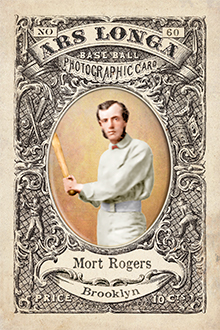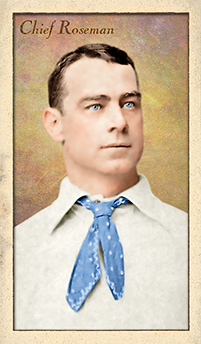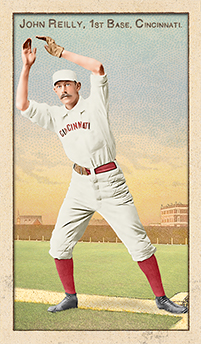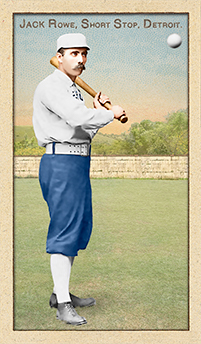
- Series: Pioneer Portraits I: 1850-1874
- City: Brooklyn
- Team: Resolute BBC
- League: National Association (NABBP)
Maxson Mortimer Rogers (1845-1881) had a profound impact on both the national pastime and the innovation of the baseball card. Unfortunately, his unique contributions have been largely lost to memory and obscured by history.
Rogers began his sporting life as a cricketer and, by the mid 1860s, had become a prominent star baseball player and executive for Civil War era teams such as the Resolute BBC of Brooklyn. By 1864, Rogers was secretary of the NABBP, baseball’s first professional league, and was elected the league’s first vice-president in 1867.
As a professional printer and entrepreneur, Rogers self-published a weekly sports paper called the New England Chronicle from 1869-1870, devoting substantial ink to the developing game he loved.
By 1871, Rogers was umpiring NABBP games in Boston while self-printing and selling “Base Ball Photographic Cards” at the games for .10 cents a piece (the price was later dropped to .05 cents). Rogers’ stated ambition was to produce a card for every prominent player in the country, but as so few of his cards exist today it is difficult to know the exact diversity or quantity of cards he was able to produce.
The Mort Rogers’ Scorecards were foldable scorecards with an image of a baseball player on the front pane (including the player’s name, position and team), a scorecard in the center two panes for that day’s game, and a group of advertisements on the rear pane. Rogers produced and sold the cards from 1871-1872.
Although there is still great debate over which card or set of cards should be considered the very first, a solid case can be made to declare Mort Rogers the Father of the Baseball Card. Ars Longa pays homage to Rogers’ legacy with this very Pioneer Portraits I series of art cards.
- A testament to his playing prowess is Mort’s inclusion in an 1865 woodcut in Frank Leslie’s Illustrated Newspaper depicting the “leading players” among NYC clubs (The woodcut includes a black-shrouded Jim Creighton in memoriam and an unidentified non-player thought to be Henry Chadwick)
- Mort’s younger brother Fraley Rogers was an early star in NY and Boston, but had an ill-starred fate as the first pro player to take his own life, at age 30, three days before Mort’s death
- Historian John Thorn, who has done groundbreaking work on contenders for “earliest baseball cards,” honors and cites Rogers’ work as the “first numbered set”
- In Mort’s honor, his Ars Longa card is numbered 60, the last in the set. The complete set will be numbered 1-58 & 60 with number 59 omitted from the series to represent the original Mort Rogers' Scorecards that are likely lost to us.

- Series: 1880s: Spotted Ties
- City: New York
- Team: Metropolitans
- League: American Association
Charles W. Reipchlager (aka Ripslager) (1856-1910) was a reserve catcher, playing the one position that didn't require an ability to hit the curve, just corral it. His major league tenure was primarily with the New York Metropolitans, beginning in 1883. He lasted four seasons as a partner with Bill Holbert, himself a light-hitting but capable receiver.
Charlie moved on to the Cleveland Blues for the '87 season where he labored in 63 games and batted .212. He would try one more time to escape the minors. He signed with the Brooklyn Gladiators for the upcoming 1890 season, only to be released before the campaign began. The Gladiators would go on to a 26-73 record that year which must have convinced Reipschlager that the majors were simply out of reach.
Reipschlager and Holbert were working behind the plate during an era of rapid change in pitching distances and pitching technique. The National League loosened the requirements for the pitching motion in 1884 but the Metropolitans' American Association didn't follow suit until mid-way through the '85 campaign. In 1886 both leagues lengthened the pitcher's “box” and placed a flat stone at the front of it to allow the umpire to police the pitcher's adherence to the defined space. The “mound” would await the 20th century's innovations.
- Reipschlager's career batting average was a meager .222, but he earned his keep in an era when short distances from the pitcher's “plate” to home made it perhaps more challenging to catch than to hit
Auction History
Cartophilia
Old Judge Pose: 386-1

- Series: 1880s: Spotted Ties
- City: New York
- Team: Metropolitans
- League: American Association
James John Roseman (1856-1938) was born on the day America celebrated its four-score anniversary and seven years before Lincoln would use that language at Gettysburg. Brooklyn-born, Chief debuted with Brooklyn Chelsea of the League Alliance in 1877. The League was a loose consortium of clubs, the brain-child of Al Spalding as a minor league serving to prepare players for the National League which had organized the prior year. Chelsea was one of 28 teams spread from New England to Minnesota. A teammate of Roseman's was Larry Corcoran who would become one of the very few to pitch in the majors using each arm. Chief moved to two other League teams in '77, and was with several other minor league clubs before joining the Troy Trojans of the NL in 1882. He was a regular in the outfield for a team led by the great Roger Connor at first. Other luminaries on that Troy team included Buck Ewing and Tim Keefe. Roseman had been with the NY Metropolitans of the Eastern Championship Association in '81 and returned to their American Association incarnation in '83 where he would be a fixture in the outfield for five seasons. Roseman concluded his MLB career with three more AA teams, finishing with Louisville in 1890.
- Chief's career average was .263 in seven seasons. He showed some power with NY where he hit 14 of his total 17 home runs
- Played in one post-season tourney, the first, in 1884, between the NL's Providence Grays and his Mets. Roseman hit .333
Auction History
Cartophilia
Old Judge Pose: 392-1

- Series: Beginnings: 1880's
- City: Cincinnati
- Team: Red Stockings (AA)
- League: American Association
John Good Reilly (1858-1937) was a one-man Big Red Machine long before the days of Bench, Morgan and Rose. When he was replaced at first base by Charles Comiskey in 1892, Long John held the Cincinnati Reds franchise records for singles, doubles, triples, home runs, runs scored, RBI, and games played. His decade with the Reds had seen Reilly consistently rank in the league's top ten in most offensive categories. In addition, his lean 6’3” frame made him a welcome first base target for his teammates. To this day, after more than a century of powerhouses in the Queen City, Reilly remains one of only four in team history to twice lead the league in HRs. In 2012 he was inducted into the Cincinnati Reds Hall of Fame, which according to the team’s website is the oldest continually operating team Hall of Fame.
- Reilly had been orphaned at age three when his father died in the Battle of Fort Donelson while serving as captain of a Union ironclad gunboat
- Long John grew up in Cincinnati as a professional artist until lured by his love of baseball. He was loyal to his hometown, retiring rather than moving to another club
- 69 career home runs were impressive for the era

- Series: Beginnings: 1880's
- City: Detroit
- Team: Wolverines
- League: National League
John Charles Rowe (1856-1911) played a decade in the major leagues for two teams, the Buffalo Bisons and Detroit Wolverines before finishing out his career with the Alleghenys and Players’ League Bisons back in Buffalo in 1890. It was his skill at bare-handed catching in the minors that attracted the Bisons’ attention in 1878, but his September call-up impressed with the bat as well when Rowe hit .353. That debut led to a seven-year tenure in upstate NY where he gained fame as part of the “Big Four” with Dan Brouthers, Hardy Richardson and Deacon White. The quartet were formidable batsmen, but a lack of pitching doomed the franchise to mediocre results. In September ‘85 the four were sold to Detroit and remained a unit until the team folded after the ‘88 season. By 1887 Rowe was primarily a shortstop and helped the club win it all, pennant and post-season, for the high-water mark of the Wolverines. Victims of the early reserve system, Rowe and White tried unsuccessfully to return to Buffalo in ‘88 as co-owners, but were held to a sale to Pittsburgh. They did make good on their plan as a Players’ League entry in 1890 for a final year in the majors for both.
- Ran a cigar store in retirement and, per the January 1899 The Sporting Life was “one of the most contented men in Buffalo these days”




